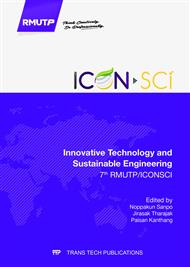p.57
p.61
p.65
p.69
p.73
p.77
p.81
p.85
p.88
Synthesis Hydroxyapatite from Three Types Eggsshells by Co-Precipitation Method
Abstract:
In the present work, hydroxyapatite (HAp) were synthesised from three types eggshells (hen eggshells, duck eggsshells and quail eggsshells) by co-precipitation method. By using recycled eggshells, there were calcined at 700-900 °C for 2 h to form calcium carbonate (CaCO3). Then, CaCO3 and ammonium dihydrogenphosphate (NH4H2PO4) were used as precursor to produce HAp. The molar ratio of Ca to P was 1.67 : 1. In order to determine the most suitable calcination temperature to produce HAp based on purity of CaCO3, HAp were investigated over the temperatures range of 800-1100 °C for 2 h. Phase formation and microstructure evolution of HAp samples were determined by using (XRD), (SEM) and (FTIR) respectively. The results showed that CaCO3 formed at 700 °C for 2 h of all eggshell types. XRD investigations show that HAp powder were stable up to 1100 °C with hexagonal structure. SEMinvestigations demonstrate that the HAp powder obtained with a sphere morphology and FTIR confirmed that the HAp powder calcined at 1100 °C corresponded to the phosphate group in PO43- with significant characteristic peaks at 1026.5 and 563.9 cm-1.
Info:
Periodical:
Pages:
73-76
Citation:
Online since:
June 2017
Authors:
Keywords:
Price:
Сopyright:
© 2017 Trans Tech Publications Ltd. All Rights Reserved
Share:
Citation:


